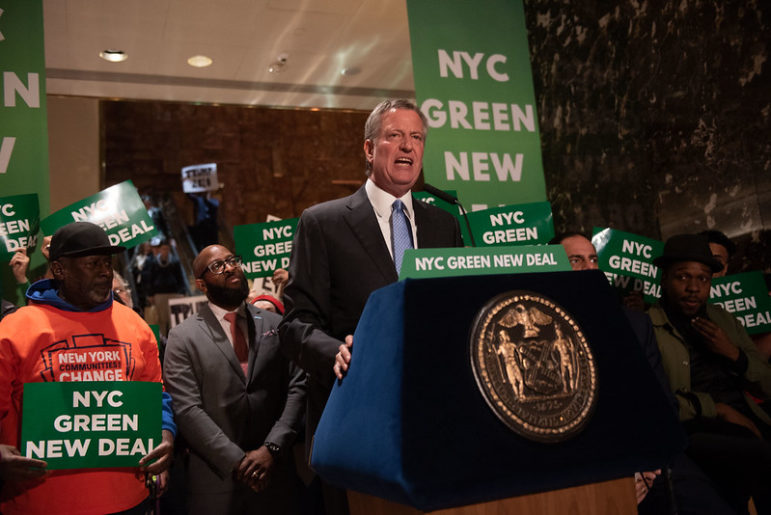The de Blasio administration has made strides toward reducing carbon emissions. But cuts to organics recycling, delays to establishing commercial waste zones, even the slowdown in closing Rikers could hamstring New York’s ability to make the fast, deep reductions that the climate emergency requires.

Michael Appleton/Mayoral Photography
Mayor de Blasio and the City Council have put the city on a path to reduce emissions from buildings, the biggest contributor to the city’s carbon footprint. But work to reduce pollution from waste, or the system that collects it, hit a snag thanks to COVID.Word that the city’s greenhouse gas emissions rose substantially in 2018 and recovered only slightly last year was unwelcome news to advocates concerned about New York’s prospects of getting greener at a fast enough pace to make a difference.
The bigger question is whether the rise in emissions between 2017 and 2019 reflects a blip or a longer-term slowdown in New York’s environmental progress.
According to the city’s detailed inventory, total greenhouse gas production fell nearly 4 percent between 2016 and 2017, but jumped 6.4 percent in 2018 before retreating 2.3 percent in 2019. In published reports, the de Blasio administration blamed extreme weather for the jump in 2018. The 55.1 tons of carbon dioxide equivalent the city pumped out last year was more than it produced in 2017, but was still lower than in 2014, 2015 and 2016.
The good news is that the Climate Mobilization Act, which targets buildings—the largest contributor to the city’s greenhouse gas total—is still rolling out. Under the law, most buildings 25,000 square feet or larger have to reduce their emissions 40 percent by the year 2030 and 80 percent by 2050. Annual emissions caps related to that goal go into effect in 2024.
The bad news is that progress on reducing other types of emissions has slowed down, largely because of COVID-19.
“I don’t think that extreme weather is the only factor,” says Melissa Iachan, senior staff attorney in the Environmental Justice Program at New York Lawyers for the Public Interest. “I do believe that this administration has taken its eye off the ball. This is an existential threat and directly speaks to the inequality that he was so concerned about.”
As the pandemic-induced fiscal crisis hit last spring, the city largely eliminated its organics recycling program, which aims to keep organic waste out of landfills, whose emissions contributed about 3.5 percent of the city’s greenhouse gas (GHG) total last year.
“We all know that tough choices had to be made” in the budget, Iachan says. But she feels the wrong choices were made. “The mayor really revealed his priorities.”
Advocates were able to save some aspects of organics recycling from budget cuts this year, preserving $7 million for community composting. However, two of the seven community composting sites—Big Reuse’s location under the Ed Koch Bridge and the Lower East Side Ecology Center—are being shut down, the former because its temporary lease with the Parks Department is up and the latter because a resiliency project is going to tear up the park where it’s located. The Parks Department says it is looking to find alternative space for the Ecology Center’s composting operation, but the organization says none has been identified.
The Parks Department’s broader policy toward composting has also come under scrutiny. Commissioner Mitchell Silver says a 2014 court decision prohibits the location of composting for outside uses on parks land, meaning parks can only host the composting of material generated by parks, and must use the composted product on parks—a legal interpretation that some advocates do not share.
Meanwhile, the city’s planned shift to commercial waste zones, which advocates say would cut down on truck traffic, was similarly pushed back because of COVID. The pause was understandable, Iachan says. “But as you delay it, you start to get worried about watering down, more delays, et cetera.”
At the same time, it’s possible that the start of congestion pricing will also be delayed from early 2021 until 2023. While congestion pricing was designed mainly as a tool to generate revenue for the transit system, it is also expected to help cut down on GHGs from transportation.
Even the slowdown in constructing new, borough-based jails to replace Rikers Island has deferred the dreams of some climate advocates, who hope that the island might become a hub for composting, additional sewage treatment capacity and some sort of solar-power infrastructure, either panels or a storage system for solar power generated elsewhere. The hope, according to advocates, is that the island would permit the closure of several “peaker” plants—outdated and polluting power stations that are activated at peak demand.
While it’s far from settled that a “renewable Rikers” will be the island’s next act, the de Blasio administration’s announcement in October that the completion date for the four borough jails would slip from 2026 to 2027. That’s not the only holdup: Two City Council measures directing the mayor’s office of sustainability and the commissioner of environmental protection to study the feasibility of green power and wastewater treatment, respectively, on Rikers Island have veto-proof levels of support but remain laid over in committee. A third measure, which would transfer control of the island from the Department of Corrections to the Department of Environmental Protection, has less support.
“We had a hearing 11 months ago. It has not moved. We’re left wondering,” Iachan says. “I guess we’re going to have to hope that the next administration has a lot more courage.”
Others say that while the sluggish movement in CO2 reduction is a problem, the de Blasio administration has done a lot to move the needle.
“New York City’s climate pollution—which in aggregate is more than most nation’s—needs to be dropping, fast,” says Pete Sikora, the director of climate and inequality campaigns at New York Communities for Change. “Past failures to enact and enforce the policies needed are the cause.” He credits the city with pioneering work during the de Blasio era to reduce building emissions and divest the city pension from fossil fuels. Council environmental chair Costa Constantinides of Queens and City Comptroller Scott Stringer, who oversees the pension funds, played leading roles in both efforts.
The de Blasio administration also developed a stringent update of the city’s Energy Conservation Code, and the mayor recently joined climate activists in opposing a pipeline project in Brooklyn.
“It’s very disturbing that the city’s climate pollution isn’t dropping in aggregate right now. At the same time, New York City is starting to take action at the scale of the crisis, which is encouraging,” Sikora says. “We have to keep the policy momentum going, and not let recalcitrant interests like the real estate and fossil fuel industries stop us.”
City Hall notes that GHG levels were slightly lower in 2019 than in 2013, the final year of the preceding administration, and that emissions by the government itself had dropped 5 percent over that period.
“Hard choices remain if we are to succeed in halting the climate emergency before us and New York City doesn’t back down from a challenge,” Laura Feyer, a deputy press secretary to the mayor, told City Limits. “We have spearheaded and are now delivering on first-of-its-kind policies from reducing building emissions to phasing out new fossil fuel infrastructure, and we look forward to working alongside the Biden-Harris administration to advance this progress.”










One thought on “Pandemic Slows Down Efforts to Reduce NYC’s Greenhouse Gas Emissions”
How can NY City significantly reduce Carbon emissions while our apartment buildings are heated with fossil fuels?